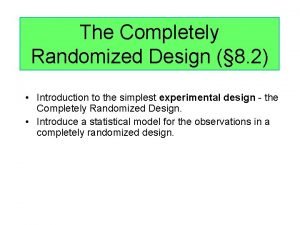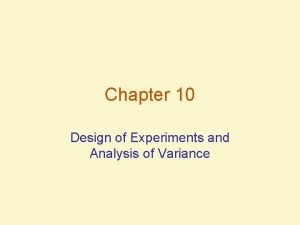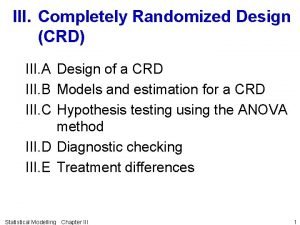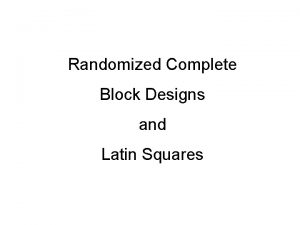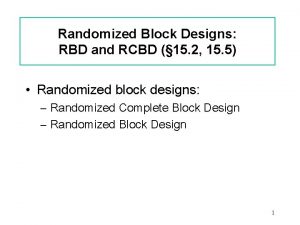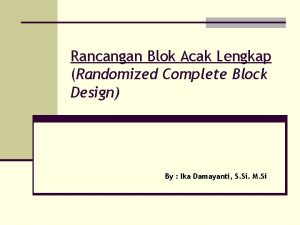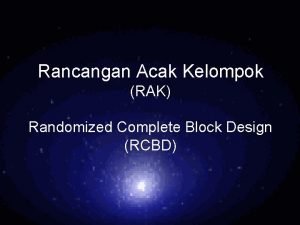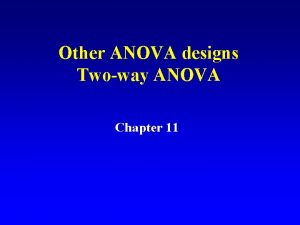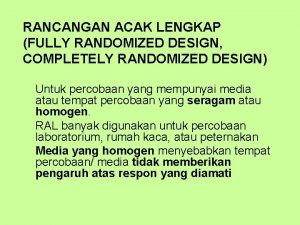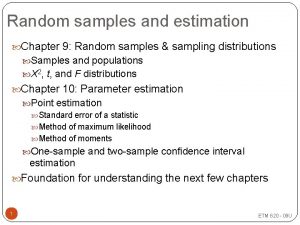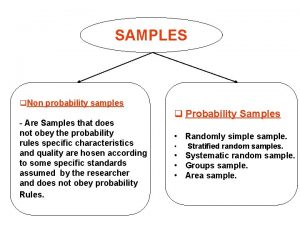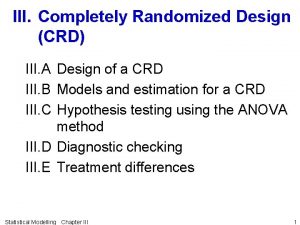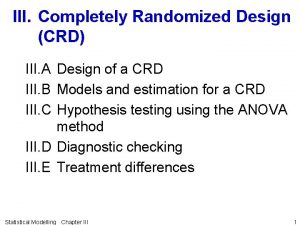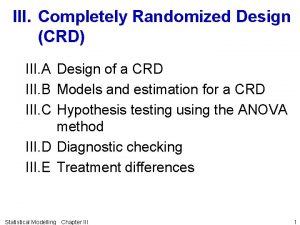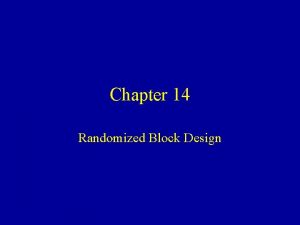The Completely Randomized Design Random samples of size
















- Slides: 16

The Completely Randomized Design • • • Random samples of size n 1, n 2, …, nk are drawn from k populations with means m 1, m 2, …, mk and with common variance s 2. Let xij be the j-th measurement in the i-th sample. The total variation in the experiment is measured by the total sum of squares: squares

The Analysis of Variance The Total SS is divided into two parts: ü SST (sum of squares for treatments): measures the variation among the k sample means. ü SSE (sum of squares for error): measures the variation within the k samples. in such a way that:

Computing Formulas

The Breakfast Problem No Breakfast Light Breakfast Full Breakfast 8 14 10 7 16 12 9 12 16 13 17 15 T 1 = 37 T 2 = 59 T 3 = 53 G = 149

• • Degrees of Freedom and Mean Squares These sums of squares behave like the numerator of a sample variance. When divided by the appropriate degrees of freedom, freedom each provides a mean square, square an estimate of variation in the experiment. Degrees of freedom are additive, just like the sums of squares.

The ANOVA Table Total df = n 1+n 2+…+nk – 1 = n -1 Treatment df = k – 1 Error df = n – 1 – (k – 1) = n-k Mean Squares MST = SST/(k-1) MSE = SSE/(n-k) Source df SS MS F Treatments k -1 SST/(k-1) MST/MSE Error n-k SSE/(n-k) Total n -1 Total SS

The Breakfast Problem Source df SS MS F Treatments 2 64. 6667 32. 3333 5. 00 Error 9 58. 25 6. 4722 Total 11 122. 9167

Testing the Treatment Means Remember that s 2 is the common variance for all k populations. The quantity MSE = SSE/(n - k) is a pooled estimate of s 2, a weighted average of all k sample variances, whether or not H 0 is true.

• If H 0 is true, then the variation in the sample means, measured by MST = [SST/ (k - 1)], also provides an unbiased estimate of s 2. • However, if H 0 is false and the population means are different, then MST— which measures the variance in the sample means — is unusually large. The test statistic F = MST/ MSE tends to be larger that usual.

Applet The F Test • Hence, you can reject H 0 for large values of F, using a right-tailed statistical test. • When H 0 is true, this test statistic has an F distribution with d f 1 = (k - 1) and d f 2 = (n k) degrees of freedom and right-tailed critical values of the F distribution can be used.

The Breakfast Problem Source df SS MS F Treatments 2 64. 6667 32. 3333 5. 00 Error 9 58. 25 6. 4722 Total 11 122. 9167 Applet

Confidence Intervals • If a difference exists between the treatment means, we can explore it with confidence intervals.

Tukey’s Method for Paired Comparisons • Designed to test all pairs of population means simultaneously, with an overall error rate of a. • Based on the studentized range, range the difference between the largest and smallest of the k sample means. • Assume that the sample sizes are equal and calculate a “ruler” that measures the distance required between any pair of means to declare a significant difference.

Tukey’s Method

The Breakfast Problem Use Tukey’s method to determine which of the three population means differ from the others. Means No Breakfast Light Breakfast Full Breakfast T 1 = 37 T 2 = 59 T 3 = 53 37/4 = 9. 25 59/4 = 14. 75 53/4 = 13. 25

The Breakfast Problem List the sample means from smallest to largest. Since the difference between 9. 25 and 13. 25 is We can declare a significant less than w = 5. 02, there is no significant difference in average attention difference. There is a difference spans between “no breakfast” and 2“light breakfast”, but not population means 1 and however. between the other pairs. There is no difference between 13. 25 and 14. 75.
 Completely randomized design
Completely randomized design Example of crd
Example of crd Randomized block design
Randomized block design Randomized design
Randomized design Completely randomized design (crd)
Completely randomized design (crd) Samples bottles are completely filled up to the neck. why?
Samples bottles are completely filled up to the neck. why? Solomon four group design
Solomon four group design Duncan's multiple range test
Duncan's multiple range test Crd rcbd
Crd rcbd Rbd design
Rbd design Randomized block design adalah
Randomized block design adalah Randomized complete block design adalah
Randomized complete block design adalah Factorial randomized block design
Factorial randomized block design Randomized block design example
Randomized block design example Random assignment vs random sampling
Random assignment vs random sampling Random assignment vs random selection
Random assignment vs random selection Successive independent samples design
Successive independent samples design
